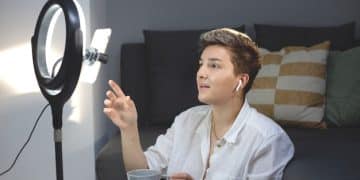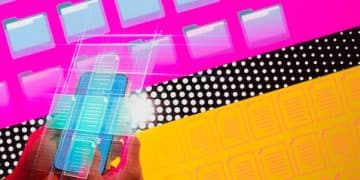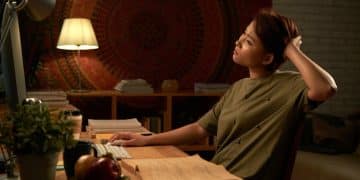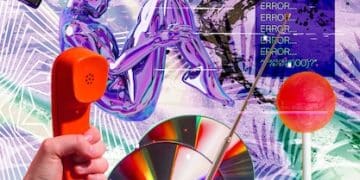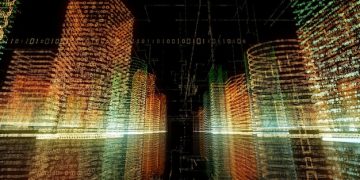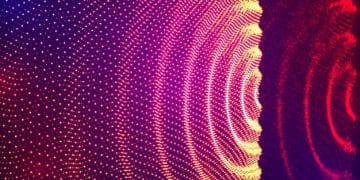AI Art vs. Copyright Law: The 2025 Legal Battle in the US
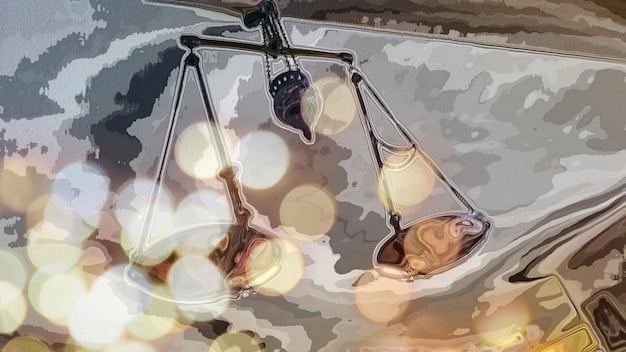
How AI-Generated Art is Challenging US Copyright Law in 2025 primarily revolves around whether AI can be considered an author, raising complex questions about originality, ownership, and the balance between fostering innovation and protecting human creativity in the digital age in the US.
The rise of AI art generators is not just a technological marvel; it’s a legal minefield. How AI-Generated Art is Challenging US Copyright Law in 2025 is a question at the forefront of legal minds across the United States, as existing copyright laws struggle to adapt to this new form of creative expression. Let’s dive into the heart of this debate.
The Author Question: Can an AI Truly Create?
At the core of the copyright debate is the fundamental question: can an AI be considered an author? Current US copyright law is predicated on the idea of human authorship. But what happens when an AI generates a unique and original work? This is a crucial point in how AI-Generated Art is Challenging US Copyright Law in 2025.
The Human Element in AI Art
While AI can generate impressive images, music, and text, the role of the human programmer and user cannot be ignored. The AI is a tool, and the final output is often a result of human prompts, parameters, and curation. Where does the human’s contribution end and the AI’s “creation” begin?
Originality and AI: A Blurred Line
Copyright law protects original works of authorship. But what constitutes “original” when an AI-generated artwork is based on a vast dataset of existing works? Is the AI simply remixing existing content, or is it creating something truly new and transformative?
- AI algorithms learn from existing datasets.
- The AI’s output is influenced by the training data.
- Determining true originality is a complex task.
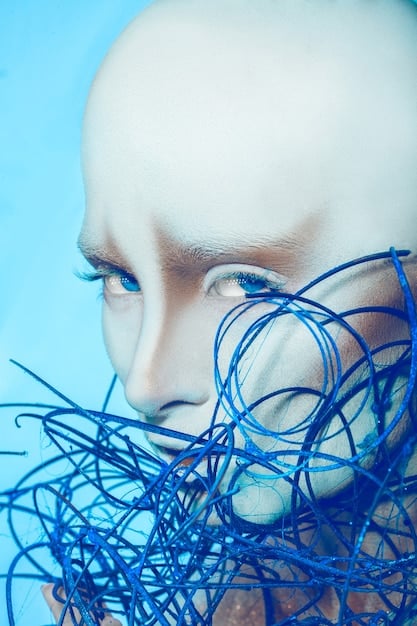
This section sheds light on the complex issue surrounding authorship on AI-generated art. As we can see, the human-AI collaboration blurs the lines of creation.
The US Copyright Office’s Stance
The US Copyright Office has already begun to grapple with the question of AI-generated art. Their stance is evolving but generally leans towards requiring human authorship for copyright protection. This position greatly impacts how AI-Generated Art is Challenging US Copyright Law in 2025.
Rejection of Solely AI-Authored Works
The Copyright Office has rejected applications for copyright registration where the artwork was created solely by AI, without significant human input. This reinforces the idea that copyright is intended to protect human creativity and expression.
Defining “Significant Human Input”
The key question then becomes: what constitutes “significant human input”? Is it enough to simply provide a text prompt to an AI generator, or does the human need to actively manipulate and refine the AI’s output to claim copyright?
These crucial questions are starting to be answered by the Copyright Office ruling on the matter.
Copyright Office Guidelines and Interpretations
Understanding the difference between AI-assisted and AI-generated requires careful consideration of inputs and outputs in various areas. Here are a few key points:
- The Copyright Office emphasizes human control over the AI process.
- Human selection and arrangement can be considered.
- The final work must be demonstrably the product of human creativity.
The US Copyright Office’s evolving positions are shaping the trajectory of this debate. Without them, the discussion around How AI-Generated Art is Challenging US Copyright Law in 2025 wouldn´t be the same.
Legal Precedents and the Evolution of Copyright Law
Copyright law has always adapted to new technologies, from photography to digital music. Examining past legal battles can provide insights into how the courts might approach the issue of AI-generated art. Understanding the evolution of copyright shapes the debate of how AI-Generated Art is Challenging US Copyright Law in 2025.
The “Monkey Selfie” Case
The famous “monkey selfie” case, where a monkey took a photograph using a photographer’s camera, illustrates the principle that copyright protection requires human authorship. The courts ruled that the monkey could not be considered an author and therefore could not hold copyright.
Fair Use and AI-Generated Art
The fair use doctrine allows for the use of copyrighted material without permission for purposes such as criticism, commentary, news reporting, teaching, scholarship, and research. Could the use of existing copyrighted works to train AI algorithms fall under fair use?

AI-generated art has a chance to influence the expansion of fair use in unexpected ways.
The Role of Transformative Use
Transformative use is a key factor in determining fair use. If an AI-generated artwork transforms the original copyrighted material into something new and distinct, it is more likely to be considered fair use. Understanding the principles behind the transformativeness of art also shapes the current debate of how AI-Generated Art is Challenging US Copyright Law in 2025.
As demonstrated, there are various legal precedents that inform the discussion of how AI-Generated Art is Challenging US Copyright Law in 2025 and the future challenges to it.
The Impact on Artists and the Creative Industry
The rise of AI-generated art has significant implications for artists and the creative industry as a whole. Concerns about job displacement, the devaluation of human creativity, and the potential for copyright infringement are all valid and need to be addressed. The fears of the creative industry are central to how AI-Generated Art is Challenging US Copyright Law in 2025.
Protecting Artists’ Rights
It is crucial to protect the rights of artists and ensure that they are fairly compensated for their work. This may involve developing new legal frameworks that specifically address the issue of AI-generated art and copyright.
Exploring New Business Models
AI-generated art also presents opportunities for new business models and creative collaborations. Artists can use AI as a tool to enhance their creativity, explore new styles, and reach wider audiences. We must consider new approaches to how this tech impacts the business.
As AI technology gains more integration into businesses, its economic impact becomes more relevant.
The Future of Human-AI Collaboration
The future of art may involve a collaborative relationship between humans and AI. In this scenario, AI becomes a powerful tool that augments human creativity, rather than replacing it altogether. The future of collaboration is a powerful point in the question of how AI-Generated Art is Challenging US Copyright Law in 2025.
This section considers the point of view from the artist, which enriches our understanding of the issues.
Potential Legislative Solutions and Policy Recommendations
As the legal landscape surrounding AI-generated art continues to evolve, policymakers may need to consider legislative solutions and policy recommendations to address the challenges and opportunities presented by this technology. The future of legislature is linked to how AI-Generated Art is Challenging US Copyright Law in 2025.
Updating Copyright Law for the AI Age
Existing copyright law may need to be updated to specifically address the issue of AI-generated art. This could involve clarifying the definition of authorship, establishing new guidelines for determining originality, and creating new mechanisms for compensating artists whose work is used to train AI algorithms.
Promoting Transparency and Disclosure
Transparency and disclosure are essential for fostering trust and accountability in the AI art ecosystem. AI art generators should be required to disclose the source of their training data and the extent to which human input was involved in the creation of the artwork.
- Labeling AI-generated content responsibly.
- Ensuring datasets are ethically sourced.
- Educating the public on AI capabilities and limitations.
These are all suggestions for how to deal with the AI challenges for legislators.
Encouraging Innovation and Creativity
Any legislative solutions or policy recommendations should aim to encourage innovation and creativity, rather than stifling it. The goal should be to create a legal framework that protects artists’ rights while also allowing for the continued development and exploration of AI art technologies.
Policy and legislative discussions are key when considering how AI-Generated Art is Challenging US Copyright Law in 2025.
The Global Perspective: AI Art and Copyright Laws Worldwide
The legal challenges posed by AI-generated art are not unique to the United States. Countries around the world are grappling with similar questions about authorship, originality, and copyright protection. The challenge is a global one, which provides context to how AI-Generated Art is Challenging US Copyright Law in 2025.
Diverging Legal Approaches
Different countries are taking different approaches to the issue of AI-generated art. Some countries may be more willing to grant copyright protection to AI-generated works, while others may maintain a stricter focus on human authorship. Comparing and contrasting these diverse approaches can provide valuable insights for policymakers.
International Treaties and Agreements
International treaties and agreements, such as the Berne Convention for the Protection of Literary and Artistic Works, may need to be updated to address the issue of AI-generated art. These agreements provide a framework for international copyright protection and could be used to harmonize legal approaches across different countries.
An overview of international agreements:
- Berne Convention relevance in the digital age.
- WIPO treaties addressing digital copyright issues.
- Cross-border implications of AI-generated content
All of this illustrates how the challenge facing legislators is truly global.
Learning from Other Jurisdictions
The US can learn from the experiences of other jurisdictions that have already begun to address the issue of AI-generated art. By studying their legal frameworks, policy recommendations, and best practices, the US can develop its own approach that is both effective and equitable.
| Key Point | Brief Description |
|---|---|
| 🤔 Authorship | AI’s capability to be an author is questioned. |
| ⚖️ US Copyright Office | Human authorship is generally required by the US. |
| 🎨 Impact on Artists | Job loss and devaluation are potential concerns. |
| 🌐 Global impact | Countries are grappling with laws on AI-generated images. |
FAQ
▼
Currently, US copyright law leans towards requiring human authorship, making it challenging for AI to be recognized as the sole author. This is due to the requirement of human input and creativity.
▼
The US Copyright Office has generally rejected copyright applications for works created solely by AI, emphasizing the need for significant human input and control over the creative process.
▼
AI-generated art raises concerns about job displacement, the devaluation of human creativity, and potential copyright infringement, necessitating the protection of artists’ rights and exploration of new business models.
▼
Potential solutions include updating copyright law to address AI-generated art, promoting transparency and disclosure in AI art generation, and encouraging innovation and creativity through balanced legal frameworks.
▼
Different countries are adopting varying legal approaches to AI-generated art, with some being more open to granting copyright protection than others. Examining these diverse approaches can inform US policy.
Conclusion
How AI-Generated Art is Challenging US Copyright Law in 2025 represents a complex intersection of technology, law, and creativity. As AI continues to evolve, it is crucial to engage in thoughtful discussions about authorship, originality, and the protection of artists’ rights to ensure a vibrant and equitable creative ecosystem for all. The legal battles of 2025 will likely set precedents that shape the future of AI art and copyright law for years to come.
